| کد مقاله | کد نشریه | سال انتشار | مقاله انگلیسی | نسخه تمام متن |
|---|---|---|---|---|
| 4921577 | 1362956 | 2017 | 12 صفحه PDF | دانلود رایگان |
عنوان انگلیسی مقاله ISI
Numerical evaluation of the performance of a Geosynthetic Reinforced Soil-Integrated Bridge System (GRS-IBS) under different loading conditions
دانلود مقاله + سفارش ترجمه
دانلود مقاله ISI انگلیسی
رایگان برای ایرانیان
کلمات کلیدی
موضوعات مرتبط
مهندسی و علوم پایه
علوم زمین و سیارات
مهندسی ژئوتکنیک و زمین شناسی مهندسی
پیش نمایش صفحه اول مقاله

چکیده انگلیسی
This paper presents the results of a finite element (FE) numerical analysis that was developed to simulate the fully-instrumented Geosynthetic Reinforced Soil Integrated Bridge System (GRS-IBS) at the Maree Michel Bridge in Louisiana. Four different loading conditions were considered in this paper to evaluate the performance of GRS-IBS abutment due to dead loading, tandem axle truck loading, service loading, and abnormal loading. The two-dimensional FE computer program PLAXIS 2D 2016 was selected to model the GRS-IBS abutment. The hardening soil model proposed by Schanz et al., (1999) that was initially introduced by Duncan and Chang (1970) was used to simulate the granular backfill materials; a linear-elastic model with Mohr-Coulomb frictional criterion was used to simulate the interface between the geosynthetic and backfill material. Both the geosynthetic and the facing block were modeled using linear elastic model. The Mohr-Coulomb constitutive model was used to simulate the foundation soil. The FE numerical results were compared with the field measurements of monitoring program, in which a good agreement was obtained between the FE numerical results and the field measurements. The range of maximum reinforcement strain was between 0.4% and 1.5%, depending on the location of the reinforcement layer and the loading condition. The maximum lateral deformation at the face was between 2 and 9 mm (0.08%-0.4% lateral strain), depending on the loading condition. The maximum settlement of the GRS-IBS under service loading was 10 mm (0.3% vertical strain), which is about two times the field measurements (â¼5 mm). This is most probably due to the behavior of over consolidated soil caused by the old bridge. The axial reinforcement force predicted by FHWA (Adams et al., 2011b) design methods were 1.5-2.5 times higher than those predicted by the FE analysis and the field measurements, depending on the loading condition and reinforcement location. However, the interface shear strength between the reinforcement and the backfill materials predicted by Mohr-Coulomb method was very close to those predicted by the FE.
ناشر
Database: Elsevier - ScienceDirect (ساینس دایرکت)
Journal: Geotextiles and Geomembranes - Volume 45, Issue 6, December 2017, Pages 558-569
Journal: Geotextiles and Geomembranes - Volume 45, Issue 6, December 2017, Pages 558-569
نویسندگان
Allam Ardah, Murad Abu-Farsakh, George Voyiadjis,